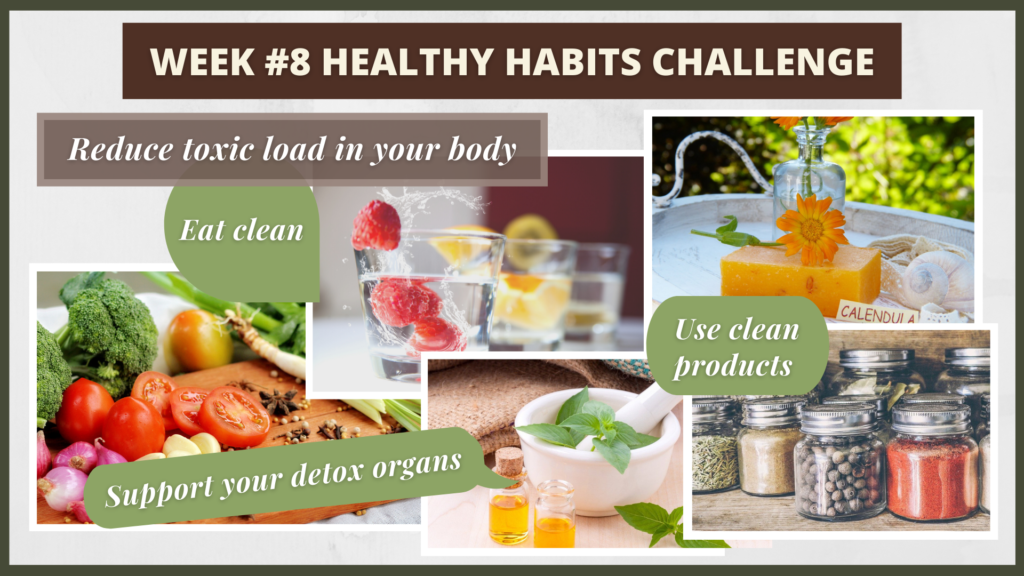Join our mailing list to receive the latest health tips and updates.
You have Successfully Subscribed!
Week #8 Healthy Habits Challenge – Reduce Toxic Load in Your Body

Welcome to Week #8 of the 12-Week Healthy Habits Challenge!
March is just around the corner. Meteorologically, March 1 marks the start of Spring season in the Northern Hemisphere.
According to ancient health practices, i.e., Ayurveda and Traditional Chinese Medicine originated from India and China respectively, Spring is considered the most important time of the year to detox or cleanse, in order to remove toxins, metabolic wastes and stagnation accumulated in the body throughout the winter months.
Modern scientific research has shown that the human body has a biological clock that adapts to seasonal change in nature. Additionally, our behavioral (diet, lifestyle) changes during wintertime also affect the physiology of the body.
Here is a summary of some of the body’s physiological changes during wintertime:
- Higher weight gain compared to other seasons.
- Increased LDL (bad) cholesterol and total cholesterol levels.
- Increased blood pressure levels.
- Increased blood glucose levels and insulin resistance.
- Increased risk of cardiovascular disease.
- Immune system exhibits pro-inflammatory state.
- Reduced vitamin D synthesis or vitamin D deficiency due to lack of sun exposure, which can result in compromised immune function and chronic inflammation.
- Compromised gut and liver health.
- Increased toxin accumulation in the body due to indoor pollutants.
Therefore, Spring detox/cleanse can be beneficial.
For more details, please check out my previous article: Spring Detox – What and Why?.
Spring is an important time but not the only time that we should try to reduce toxic load in the body. In our modern living we are constantly exposed to numerous (as high as10s of thousands of) toxins in our daily life – living environment, foods, water, personal care products, household products, other consumer products, etc.
A recent scientific study published in October 2021 showed that synthetic chemicals called phthalates, widely used in consumer products (incl. plastic food packaging, cosmetics, children’s toys, PVC products, medical devices) may contribute to an estimated 100 thousand premature deaths each year among elderly people (the study subjects age from 55 to 64) in the United States.1
Phthalates are just one of the many toxic chemicals ubiquitously present in our daily life. Other prominent ones include BPA, PFAS, PBBs, PBDEs, pesticides/herbicides, etc., all of which have been shown to adversely affect our health, contributing to many chronic diseases/disorders.
Such chronic diseases/disorders include cancer, hormonal disruption, reproductive dysfunction, brain/neurological/mental disorders, impaired immune system, gut dysfunction, impaired lung/respiratory health, damage to detox organs (liver, kidneys, gut), oxidative stress & chronic inflammation (which in turn are main underlying culprits of heart disease, diabetes, obesity, cancer, Alzheimer’s, etc.), and nutritional compromise.
For more details on how toxins ubiquitously present in our daily life can affect our health and contribute to many chronic diseases as shown by scientific research, please check out my previous article: How Toxins Affect Your Health and Tips to Reduce Toxic Load.
Please continue reading the next section for some key tips to reduce toxic load in the body.
Tips to Reduce Toxic Load in the Body
To reduce toxic load in the body, the first and foremost step is to minimize toxin exposure. It is always better to prevent toxins from entering the body, rather than removing toxins from the body after they have made their way in.
Additionally, we also want to facilitate removal of toxins that have entered the body.
Here are some key tips:
- Minimize toxin exposure from foods including pesticides/herbicides, food additives/chemicals
- Choose organic and whole foods as much as possible.
- Avoid or minimize consumption of processed foods.
- Eat lower in the food chain (i.e., whole food plant-rich diet).
- Drink clean/filtered water.
- Minimize toxin exposure from lifestyle choices and the environment
- Check labels for ingredient list and choose natural personal care and household cleaning products that are void of harmful chemicals.
- Choose cleaner cookware and utensils by avoiding aluminum, plastic, Teflon or generally non-stick coated cookware and utensils.
- Clean your indoor air by using an air purifier that has high-grade HEPA filter, and choose low-toxicity furniture and building supplies.
- Support the major detox organs (liver, kidneys, gut)
- Adopt a whole food plant-rich diet which is naturally anti-inflammatory and antioxidant-rich.
- Ensure adequate sleep (see Week #2 Healthy Habits Challenge for tips).
- Maintain healthy weight through nutrient-dense whole food diet and adequate exercise.
- Manage stress through lifestyle adjustments and relaxation techniques (e.g., yoga, Tai Chi, meditation, diaphragmatic breathing, etc.).
- Maintain healthy vitamin D levels through adequate sun exposure and/or supplementation
- Avoid cigarette smoking.
- Support toxin excretion from the body
- Support regular sweating through exercise and/or sauna.
- Ensure healthy bowel movement (see gut health in tip #3 above).
- Support healthy bile flow by supporting liver/gallbladder health (see liver health in tip #3 above).
- Support lymphatic drainage through physical movement/exercise, deep breathing, dry skin brushing, infrared sauna, adequate sleep, etc.
- Drink plenty of clean water to facilitate transport of toxins in lymph, sweat and urine (see Week #1 Healthy Habits Challenge for tips).
For more comprehensive list of tips, please check out my previous article: How Toxins Affect Your Health and Tips to Reduce Toxic Load.
Related Articles
How Toxins Affect Your Health and Tips to Reduce Toxic Load
Week #1 Healthy Habits Challenge
Week #2 Healthy Habits Challenge
References
- Trasande L, Liu B, Bao W. Phthalates and attributable mortality: A population-based longitudinal cohort study and cost analysis. Environ Pollut. 2022;292(Pt A):118021. doi:10.1016/j.envpol.2021.118021
